hnsc 1210 unit 6 - the proteins and amino acids
1/75
There's no tags or description
Looks like no tags are added yet.
Name | Mastery | Learn | Test | Matching | Spaced |
|---|
No study sessions yet.
76 Terms
proteins are compounds made up of
carbon
hydrogen
nitrogen
our body’s working proteins
enzymes
antibodies
hormones
oxygen
carriers
etc
other structural proteins
tendons
ligaments
fibres of muscle
found in our bones
teeth
hair and nails
proteins are arranged in strands of
amino acids
amino acids
building blocks of protein
amino strands differ from one another
protein strand could have 20 different amino acids
amino acids have same chemical backbone
single carbon atom with amine group and an acid group attached
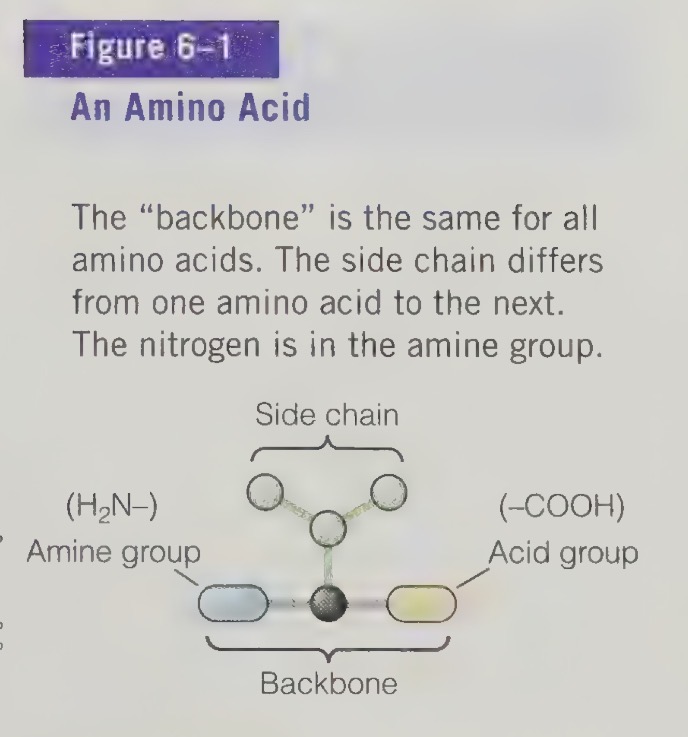
amino acid side distinctive side chain
gives identity and chemical nature
make amino acids differ in size, shape, and electrical charge (pos, neg, or neutral)
how many amino acids make up most of the proteins of living tissues
20
there are a few additional amino acids that rarely appear in a few proteins
the body making amino acids
can make 20 amino acids itself
essential amino acids
healthy body cannot make those amino acids or cannot make enough to meet the body’s need
these amino acids must be derived from food so the body can make the proteins it needs
TV TILL PM
what are the essential amino acids
tryptophan
valine
threonine
isoleucine
leucine
lysine
phenylalanine
methionine
TV TILL PM
body is able to recycle amino acids
by breaking apart food proteins after digestion, and body proteins after they have completed their cellular work
this allows for an emergency supply of amino acids for times of fuel, glucose, or protein deprivation
how does recycling amino acids sacrifice the working muscle tissue?
using the most dispensable muscles first and leading the organs and heart protein until dire need
how are amino acids joined together
peptide bonds
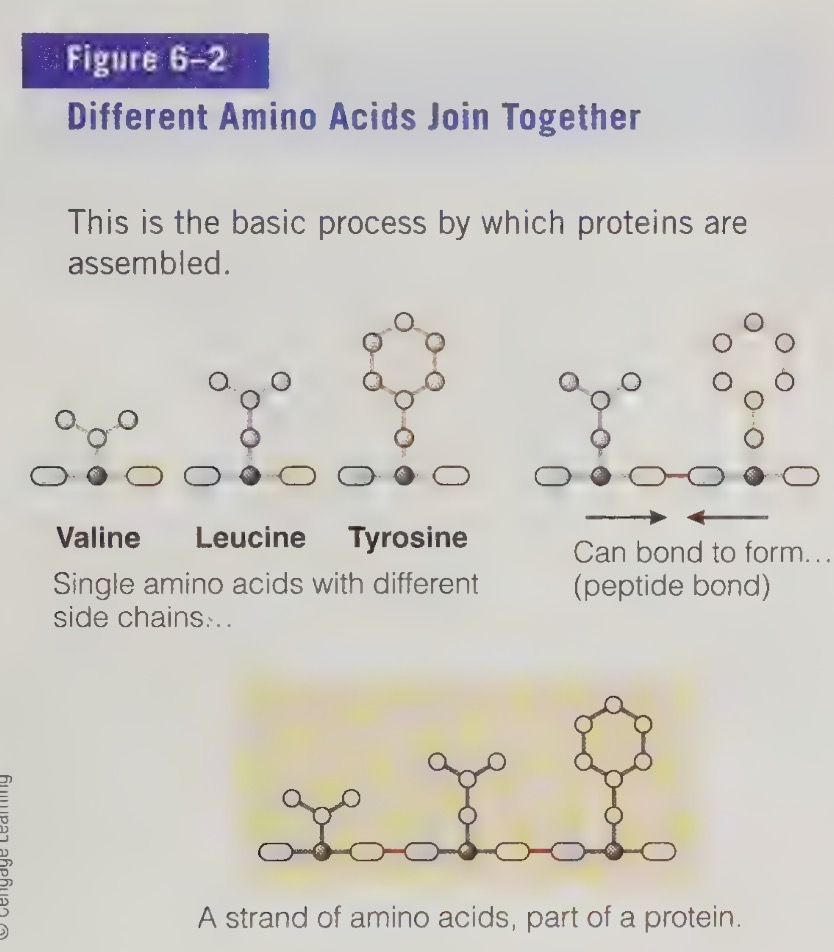
peptides
2 amino acids = dipeptide
3 amino acids = tripeptide
>3 amino acids = polypeptide
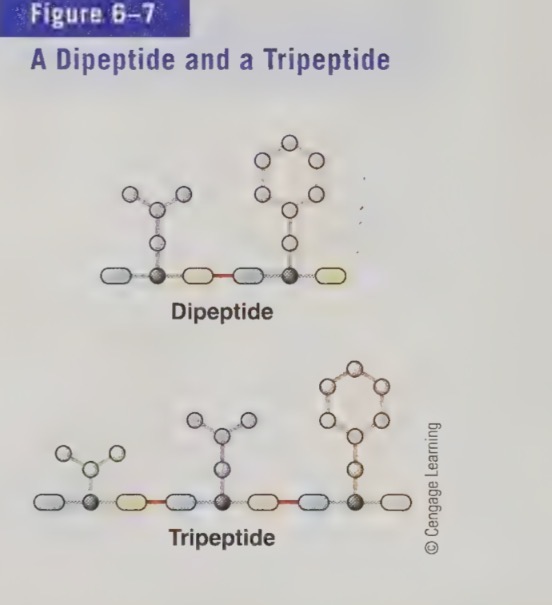
protein
several dozen to 300 amino acids joined together
strand f protein does not remain in a straight line
electrical changes of the amino acids (caused by the side chain) cause the strand to bend and coil, as amino acids attract and repel one another
forms either a globular or fibrous shape
coiling an folding of a protein molecule
first shape of a strand of amino acids is a chain, can be very long - primary structure
coiling the strand: amino acids attract takes springlike shape as their side chains variously attract and repel each other - secondary structure
folding the coil: coil then folds and flops over itself to take a functional shape - tertiary structure
once coiled and folded: protein may be function as is, or it may need to join with other proteins, r add a carbohydrate molecule of a vitamin or mineral, as the iron of the protein hemoglobin demonstrates
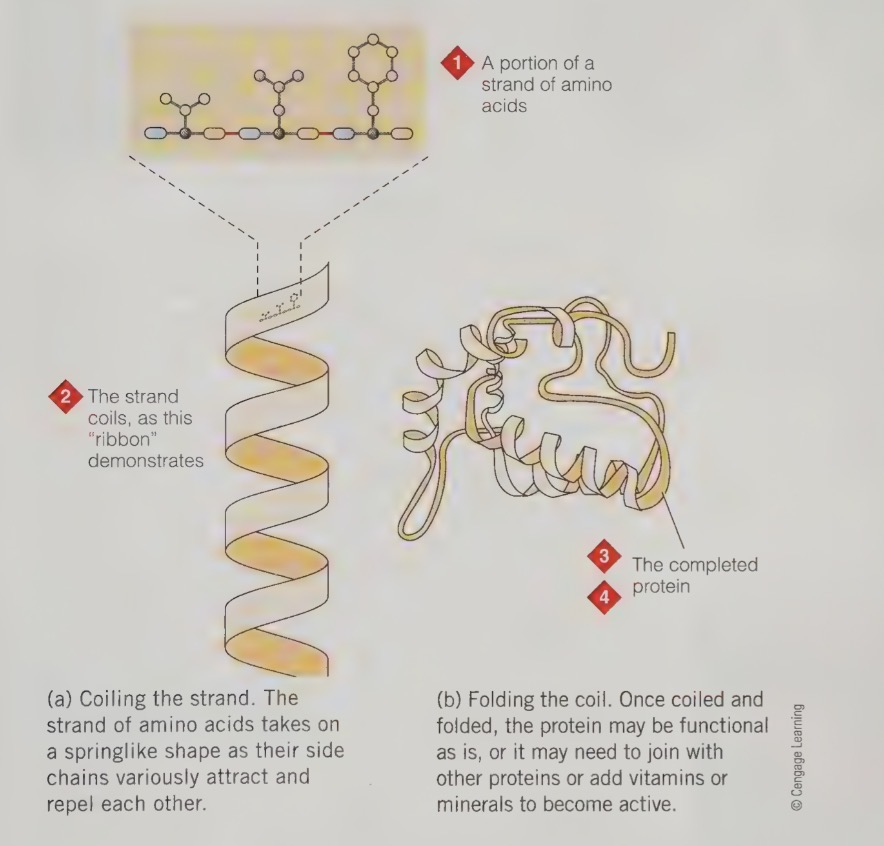
amino acids with electrically charged side chains attract water
are oriented on the outside of the protein structure
neutral amino acids repel water
are attracted to one another
orientate in the centre of the protein away from body fluids
these interactions give each protein a unique structure
protein synthesis
specific structure/shape of proteins enables them to perform different tasks in the body
some protein strands function alone, while others associate with other proteins in order to become active
there is a vast array of different proteins
alphabet analogy: 26 letters that make up million of words
20 amino acids hat can be combined in many different ways
single human cell ca contain as many as 10,000 different proteins
steps to protein synthesis
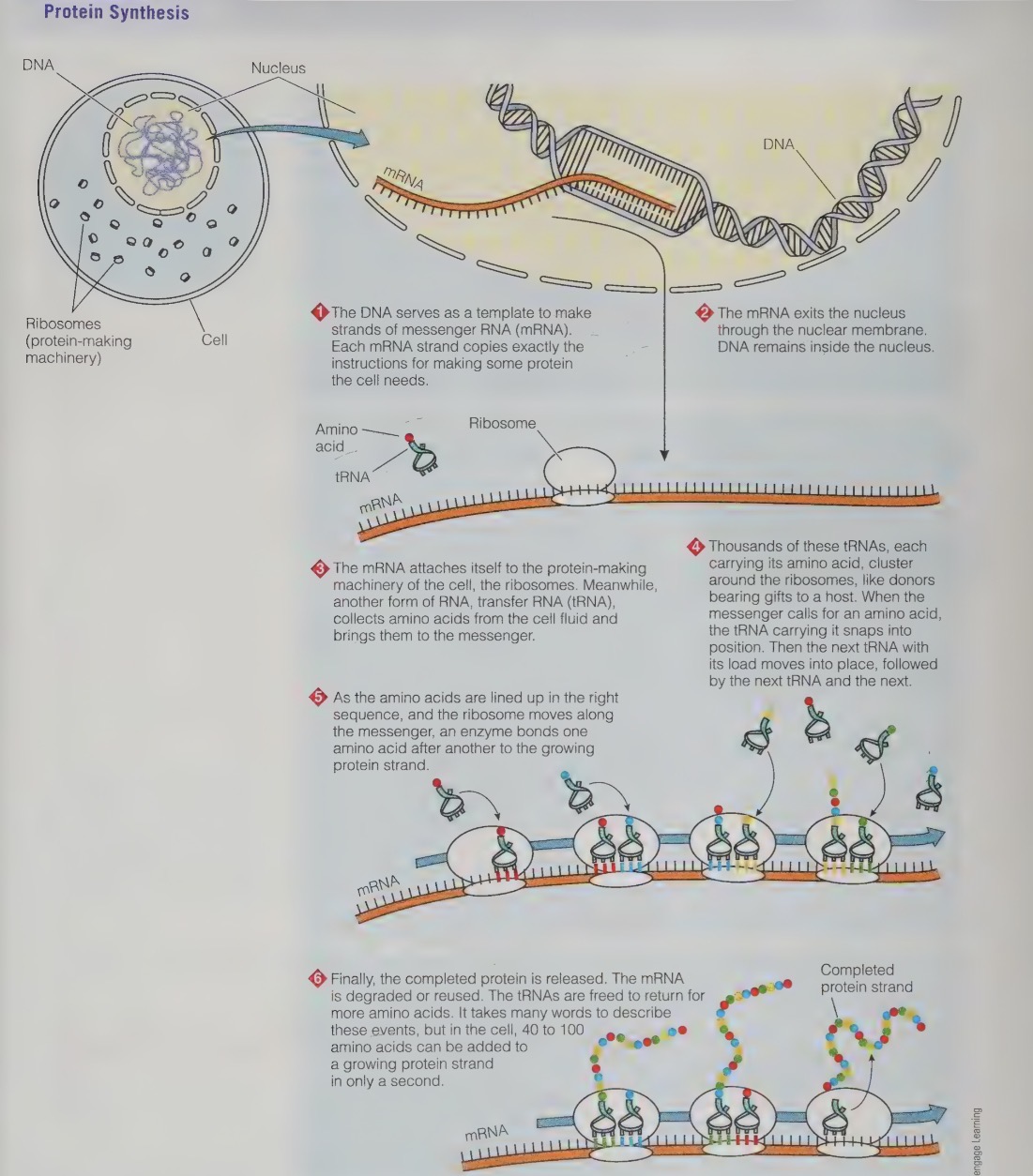
what do our genes determine
sequence of amino acids in each finished protein
different sequences account for genetic diseases (e.g sickle cell disease)
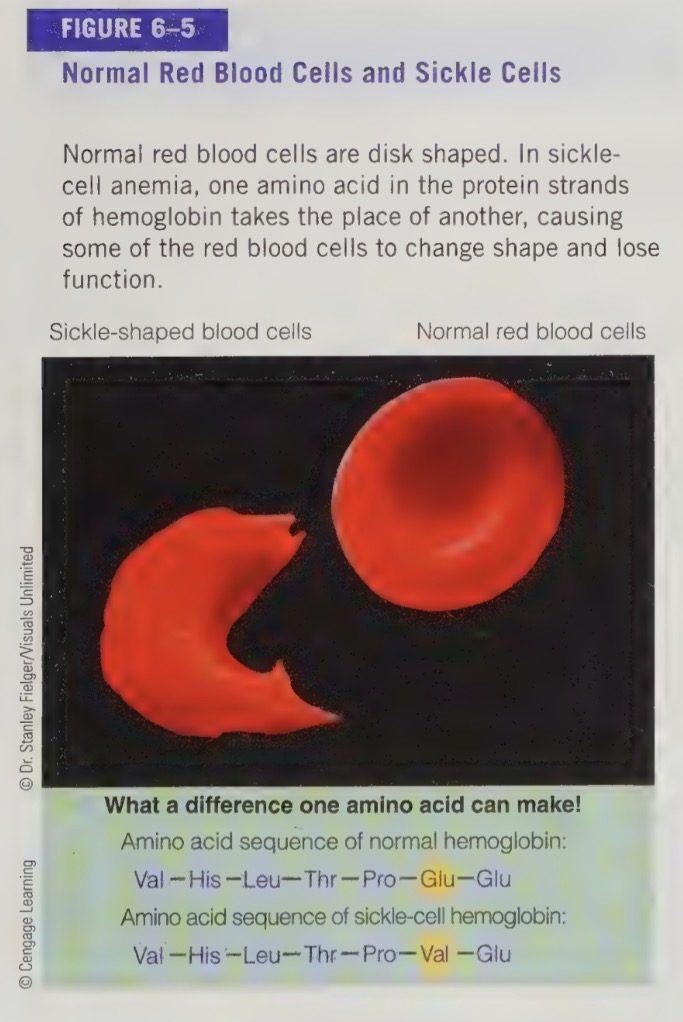
for each protein, there exists a standard amino acid sequence which is specified by heredity
if wrong amino acids is inserted, it can result in disastrous health consequences
sickle cell disease
condition where hemoglobin is abnormally shapes and loses its function to carry and release oxygen
this is because on protein strand contains valine as the 6th amino acid instead of glutamic acid
if too many crescent shaped calls appear in the blood, abnormal blood clotting, strokes, susceptibility to infection, severe pain and early death
protein digestion
person eats foods proteins from any source, the body must first alter them y breaking them down into amino acids
then it can be rearrange them into specific humanly proteins
protein digestions start starts in the stomach. gastric acid denatures the protein, meaning that it changes the shape of the protein meaning that it changes the shape of the protein strand, opening it up to allow digestive enzymes to cleave/ break the peptide file
by the time most proteins enter small intestine, they are broken into smaller pieces. protein digesting enzymes from the pancreas and the intestine split poly into di and tripeptides and single amino acids
enzymes of intestinal lining split di and tri to be able to enter the blood stream, the amino aids are transported to al of the body’s cells
sometimes large molecules escape digestive process and enter the bloodstream in take - though they may act as hormones to regulate body functions and provide information to the body about external environment. may also stimulate and immune response, thus laying a role ito food allergies
protein digestion in the body
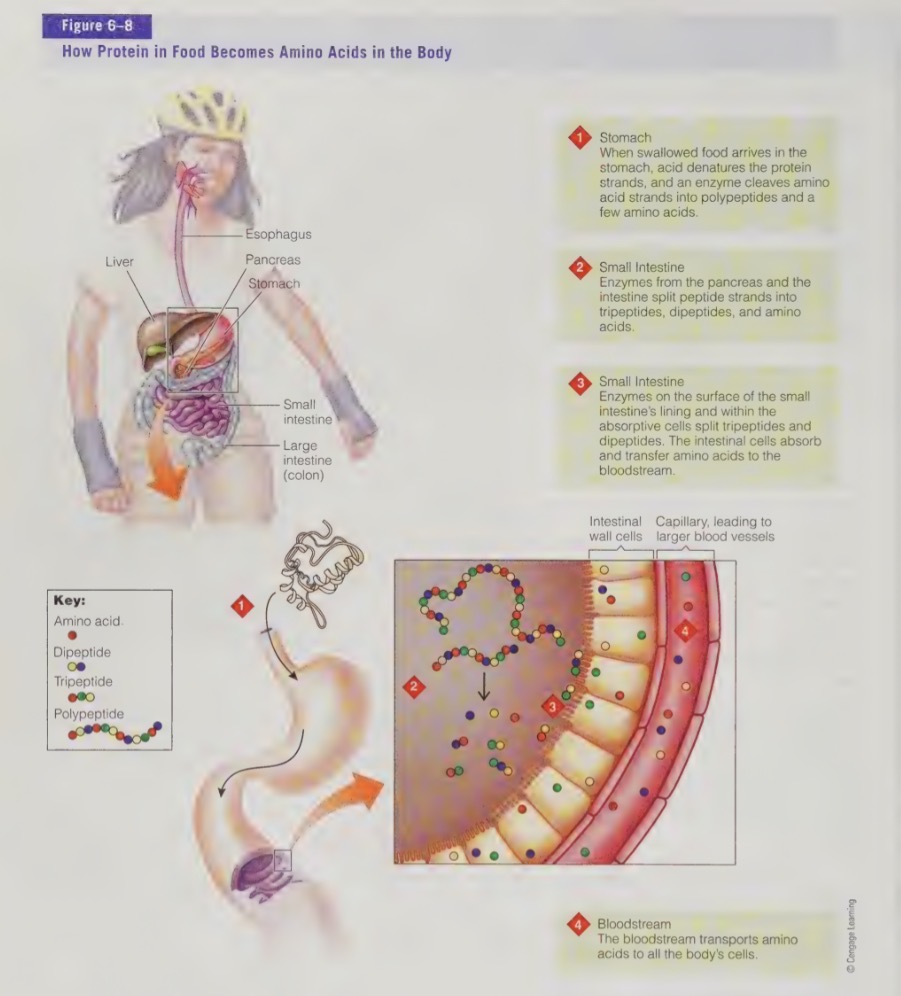
denaturing proteins
heat
acid
bases
salts of heavy metals i.e mercury
ex. egg becomes firm and easy to digest due to protein denaturing when cooking
ex. when digested heavy/ harmful chemicals drink milk so they denature milk proteins instead of u and induce omitting.
protein absorption
cells of the small intestine posses separate sites to absorb different types of amino acids
amino acids of the same type compete for the same absorptive sites
therefore consuming a large dose of any amino acids may limit the absorption of other amino acids of the same general type - this is the one reason to take caution against taking single amino acids as supplements
amino acids circulating in the bloodstream
they travel to the liver where they are used or released back into the blood and taken up by other body cells
these cells can then link the amino acids of ether to make proteins that they keep for their use or release into the lymph or blood for other uses
body can also use amino acids for energy if necessary
functions of proteins
acid-base balance: proteins help maintain the acid-base balance of various body fluids
antibodies: proteins from the immune system molecules that fight disease
blood clotting: proteins provide the netting on which blood clots are built
energy: proteins provide some fuel for body’s energy needs
enzymes: proteins facilitate needed chemical reactions
fluid and electrolyte balance: proteins form integral parts of most body tissues, such as skin, connective tissue, muscle, organs, and bone
hormones: proteins regulate body processes. some hormones are proteins or are made from amino acids
transportation: proteins help transport needed substances, such as lipids, minerals, and oxygen around the body
vision: various proteins called options are important for both colour and night vision
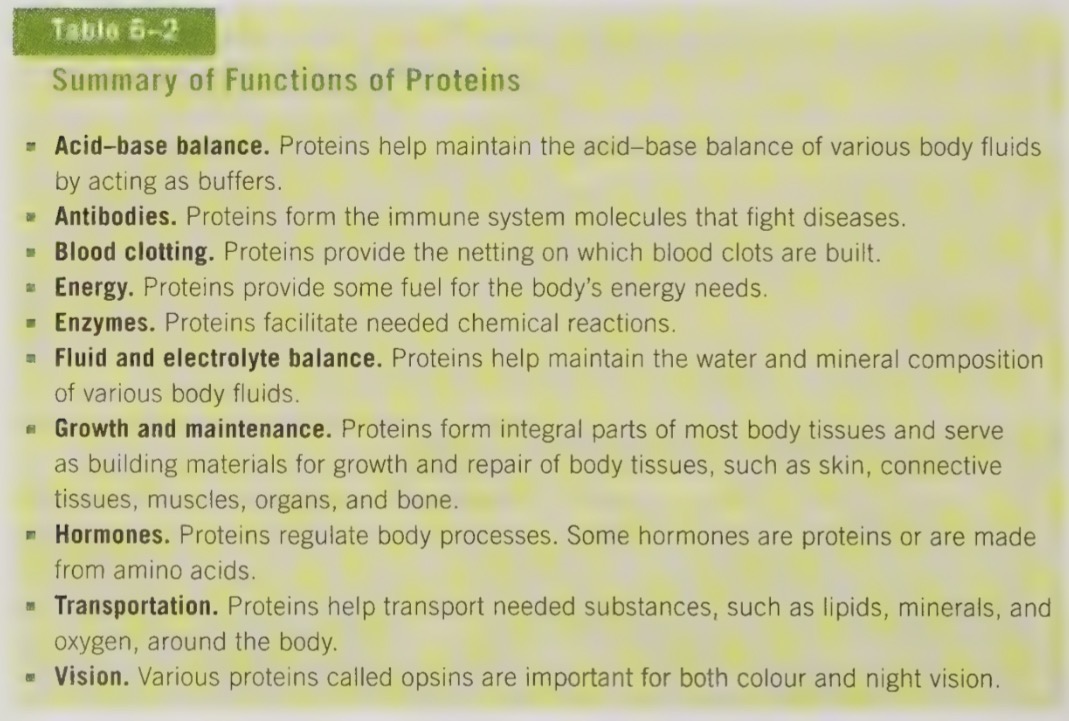
functions of proteins: supporting growth and maintenance
amino acids must be continuously available to build proteins of new tissues
proteins also helps to replace worn out cells and internal cells (e.g red blood cells only live 3-4 months, cells of lining 2-3 days) body needs dietary amino acids to grow new cels and replace worn-out ones
functions of amino acids: building enzymes, hormones, and other compounds
enzymes act as catalysts to speed up specific chemical reactions
important proteins formed in living cells
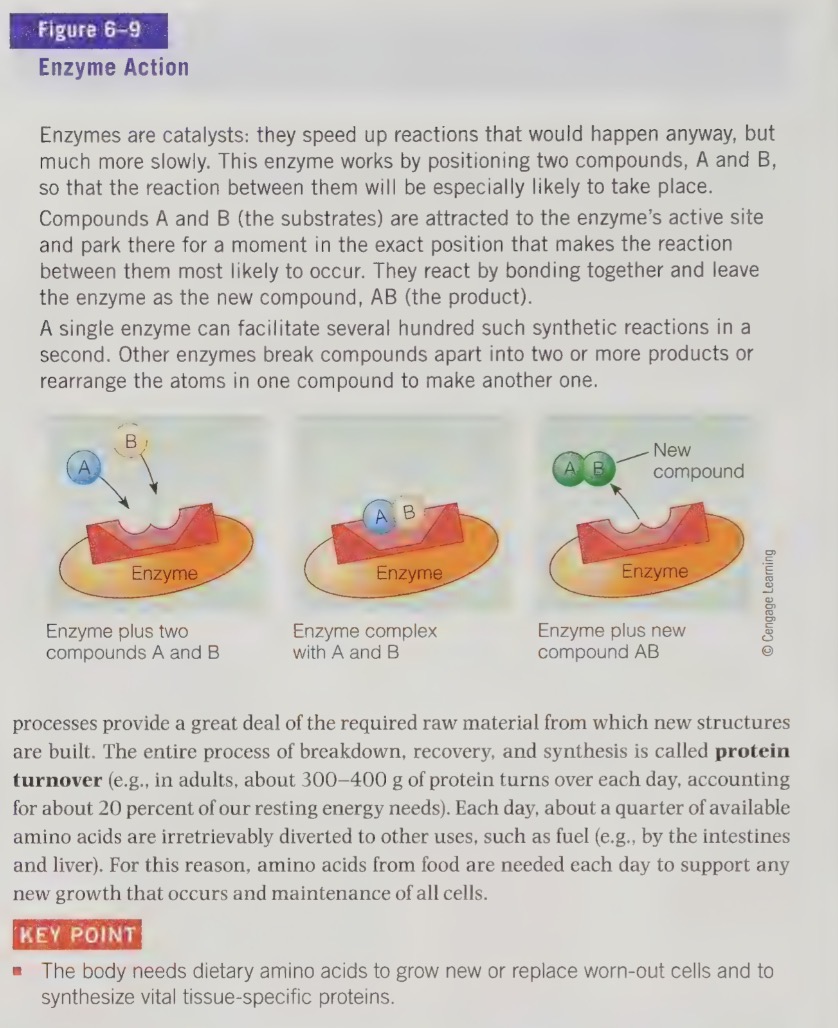
functions of proteins: building antibodies
antibodies attack foreign particles while recognizing the body’s own proteins and leave them alone
each antibody designated to destroy one specific invader
used to fight one strain of the flue will not be effective against another strain
body remembers how to make the antibody again, therefore developing immunity to the invader
functions of proteins: maintaining fluid and electrolyte balance
proteins regulate quantity of fluids in the compartments of the body
cell must maintain constant amount of fluids to remain alive
water can diffuse freely in and out of cells, proteins cannot and they attract water
maintain stores of integral proteins, help cells to retain the fluid they need
if system fails (e.g protein deficiency) too much fluid collects in the spaces between the tissues, causing edema
transport proteins also hold electrolytes in proper chambers
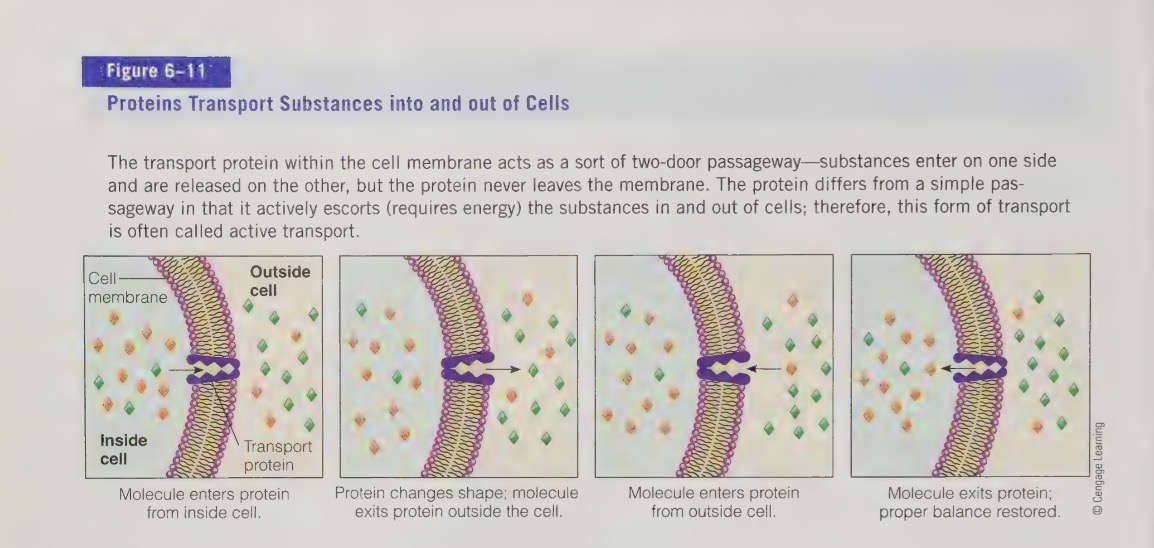
functions of proteins: maintaining acid-base balance
specific proteins act as buffers to maintain the bloods norma pH
they do this by picking up hydrogen molecules (acid) when there are too many in the blood stream, and releasing them when there are too few
functions of protein: clotting of blood
special blood proteins respond to injury by forming a stingy net that traps blood cells to form a clot
clot act as a plug to stop blood flow from the wound
proteins are also involved as the wound healers; protein collagen replaces the clot with scar tissue
functions of protein: providing energy and glucose
under normal conditions protein provides very little energy
diet deficiency in CHO or total energy, protein use speeds up - secondary function for protein
protein is broken down into energy and nitrogen, either used or sent to the liver
converted to urea then sent to kidney fro excretion in the urine
fragments that remain are carbon, hydrogen, and oxygen, used to build glucose or fatty acids
amino acids can be converted to glucose, protein can help maintain a steady blood glucose level and serve the glucose needs of the brain as need arises
no specialized protein storage in the body
when body amino aids are required for energy, body must dismantle it tissue proteins, leading to lean body tissue waiting
if body takes excess amino acids, the body cannot store them - it will remove and excrete amine group and use the remaining fragments to support the body’s energy needs, convert to glucose for storage as glycogen or convert to fat or storage
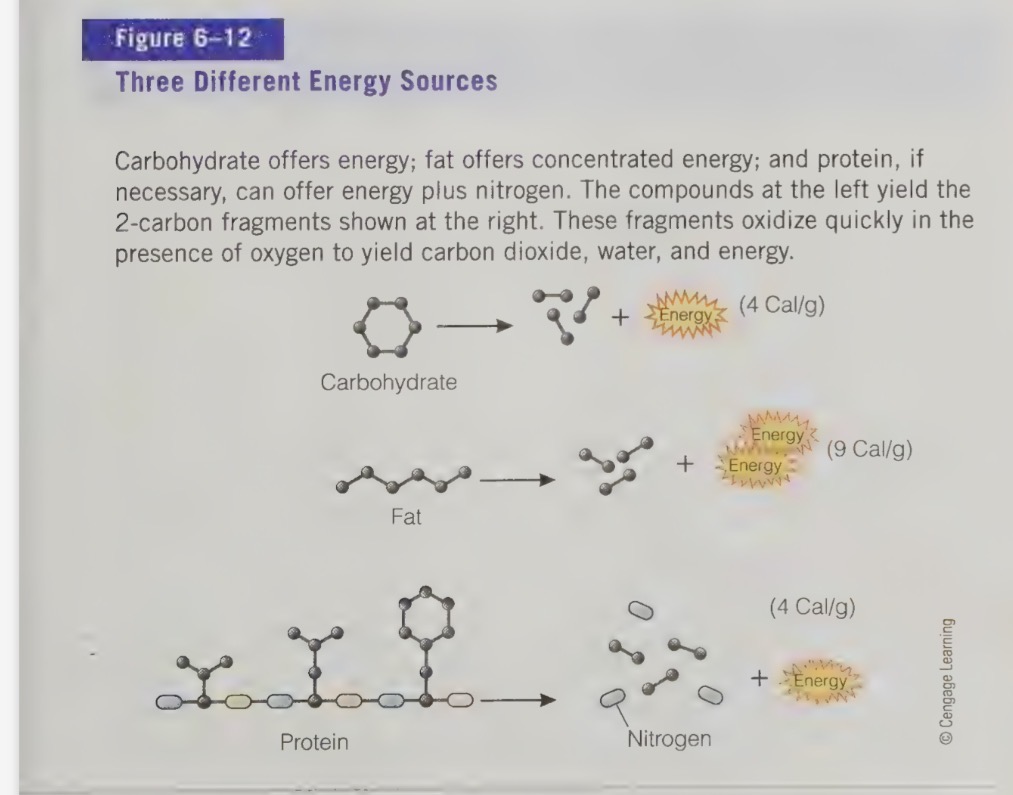
protein utilization: amino acids arrives at cell
can be used in several ways
It can be used to build part of a growing protein
It can be altered to make another needed compound (e.g., the amino acid tryptophan can be converted to make niacin (a B vitamin we will look at further in unit 8)
The cell can dismantle the amino acid in order to use the amine group to build a different amino acid. After the amine group is removed, the remainder can be used for energy or converted to glucose or fat for storage. If the body is not using the amine group to create a different amino acid, it will be excreted from the cell, and then from the body as urine.
protein utilization: amino acids considered waste when not used to build protein or other nitrogen-containing compounds. occurs if these 4 conditions exist
When the body does not have enough energy from other sources
When the diet provides more protein then the body needs
When the diet has too much of any single amino acid (such as from supplements)
When the diet supplies protein of low quality, with too few essential amino acids.
to prevent the wasting of dietary protein and allow for the synthesis of needed body protein, dietary protein must be:
Adequate in quantity
Supply all essential amino acids in the proper amounts
And must be accompanied by adequate energy from CHO and fat.
food protein: quality, use and need
protein found in all four food groups
meat and alternatives, and milk and alternatives food groups contribute an abundance of high-quality protein
smart amounts of proteins are also contributed by vegetables and fruit, and grain products food groups contribute
protein recommendations
people in developed countries at more than ample protein
DRI: 0.8g/kg body weight; so for an average women: 46g/day, average men: 56g/day.
DRI Acceptable Macronutrient Distribution Range (AMDR): 10-35r% total energy
protein quality & quantity
helps us determine how well a diet supports growth of children and the health of adults
it is influence by digestibility of the protein and its amino acid composition
response of the body to dietary protein depends on many factors
body’s state of health
other nutrient
energy consumed at the same time
proteins quality
in malnutrition
digestive enzymes secretion slows as the digestive tract lining degenerates, imparting protein digestion and absorption
protein and infection
additional protein required to nuance immune function
for efficient use of protein, it must be accompanied by the full array of vitamins and minerals
digestibility
in general, amino acids from animal protein are most easily digested and absorbed (>90% of protein absorbed)
legume are next (~80-90%)
followed by grain and plant proteins (70-90%)
cooking with moist heat (e.g. steaming or poaching)
amino acid composition
high quality proteins are ones with ample amounts of all essential amino acids
low quality proteins do not
within a single day of restraints essential amino acid intake, the body starts to limit the break down of working proteins and reduce amino acid use for fuel to conserve the essential amino acids it currently has
a diet short in any of the essential amino acids limits protein synthesis
in building protein, no other amino acid can fill another’s spot
if a cell building a protein cannot find a needed amino acids, protein synthesis stops and the partial protein is released
these partially completed proteins are not stored until the amino acid is available
they are instead dismantles and the amino acids are released back into circulation
they are either picked up by other cells, or are dismantles and used for others purposes
complimentary proteins
person can get all amino acids by eating essential amino acids via meat, fish, poultry, egg, legumes
plant diet - eat a variety of different plant foods to maximize amount you get
mutually supplement
complementary proteins - have all AA needed, don’t need to be consumed in one meal
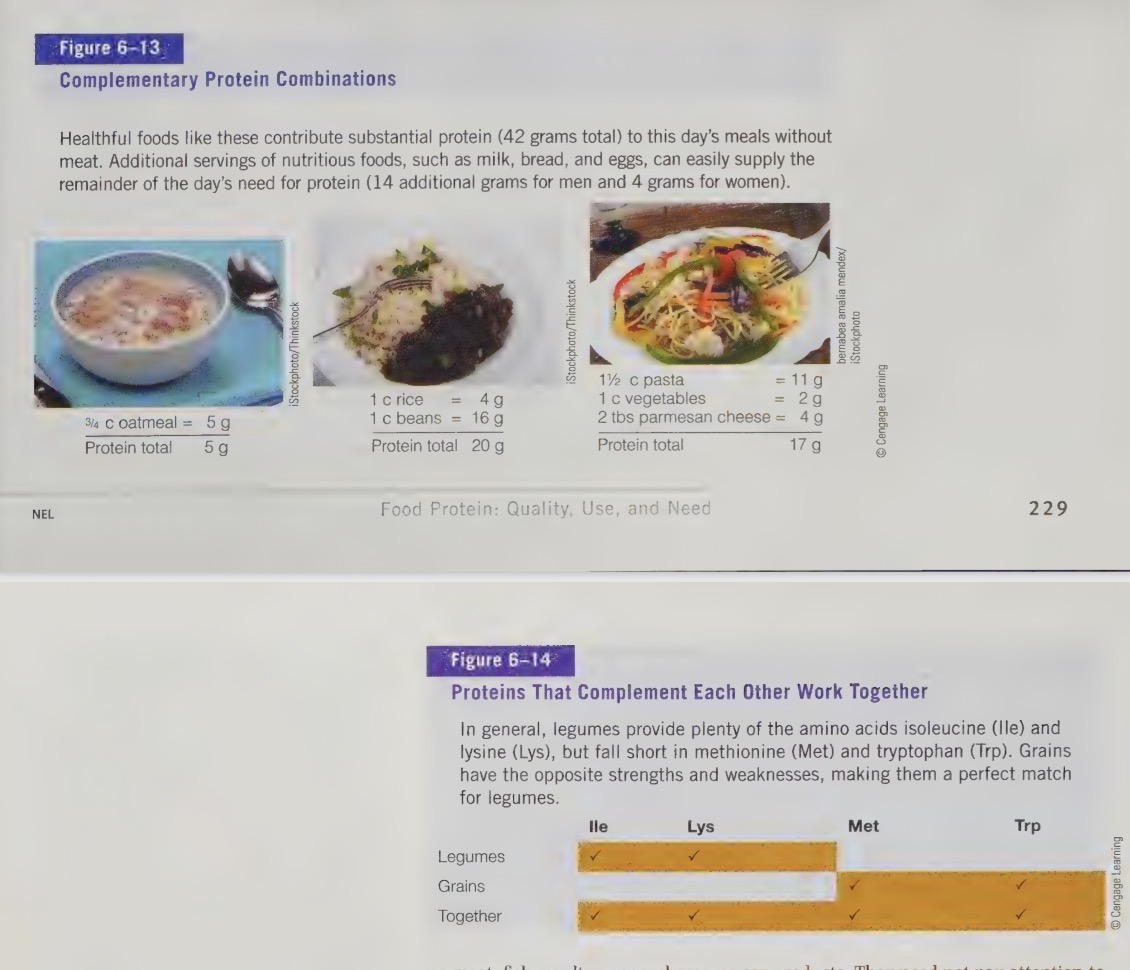
nitrogen balance
protein recommendations are based on nitrogen balance studies, which compare nitrogen lost through excretion with the nitrogen eaten in food
under normal circumstances, healthy adult are in nitrogen equilibrium, meaning they have roughly the same amount of protein in their body at all times
positive nitrogen balance
nitrogen in exceed nitrogen out
somewhere in their bodies, more protein is being built than are being broken down (e.g growing children, pregnant women)
negative nitrogen balance
nitrogen out exceeds nitrogen in
muscle or other protein tissue is being broken down and lost (e.g illness, injury)
also astronauts: stress of space fight and no need to support body’s weight against causes muscle to weaken and waste
protein energy malnutrition
combination of protein deficiency and energy deficiency
PEM is the world’s most widespread form of malnutrition - over 500 million children face impending starvation and suffer the effects of malnutrition and hunger
33,000 children die everyday due to malnutrition
PEM prevalent in africa, central america, south america, the middle east, and west asia - not immune to it in NA (chronic disease, poverty, ED)
PEM strikes in early childhood, often stunted growth, affects adult as well
two forms of PEM
marasmus and kwashiorkor
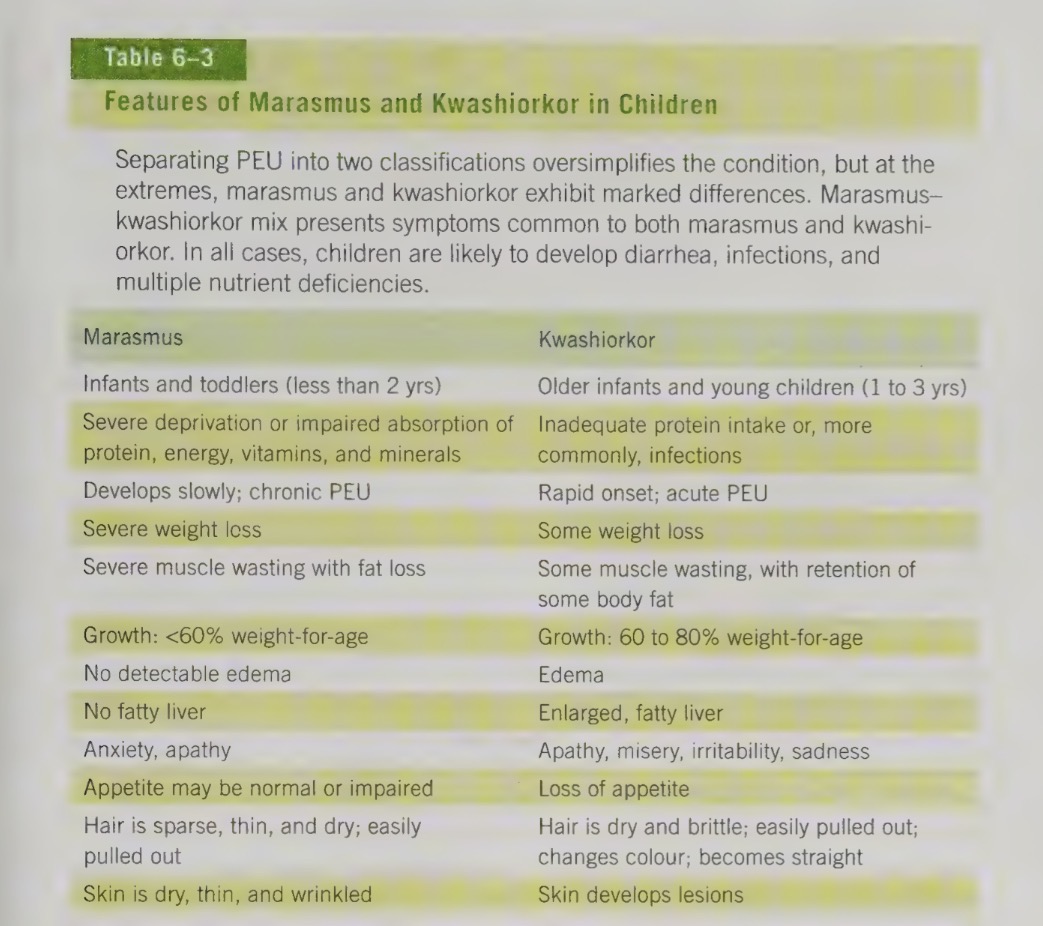
marasmus
chronic inadequate food intake, total diet deficiency
slow form of PEM
children 6-18 months who live in overpopulated city slums
malabsorption occurs because digestive enzymes are in short supply and digestive tract lining deteriorates
child experiences severe weight loss, including muscle and fat loss
child appear thin in appearance (match stick arms)
muscles (including heart)) weaken and brain development ins stunted and learning is impaired
hair becomes sparse, thin, pulls out easily
dry skin, thin, wrinkled
infection of intestinal tract which causes diarrhea (dysentery) can occur causing further depletion of nutrients
rate of infection increases and kwashirokor often follows because the body is suing more protein to try and fight infection
kwashiorkor
severe acute malnutrition with too little protein to support body function
children 1-3
Ghanaian name for “evil spirit that infects first child when the second is born”
first baby is weaned from breast milk as soon as he second is born
child loses out on high-quality protein source and are often given watery cereal instead
some symptoms similar to marasmus, but differ
hair dry and brittle, easy to pull out, change colour (insufficient tyrosine) and will straighten
skin scaly and patchy with lesions
serve wasting of body fat or muscle is not seen, so child does not look wasted in appearance
protein and hormones responsible for maintaining fluid balance are diminished - edema
belly often protrudes because of fatty liver, caused by lack of transport proteins to move fat out of liver
child suffering often does not look malnourished
protein excess
over consuming protein is not good
DRI recommend no more than 35% of total calories come from protein
may pose health risk for heart or weaken kidneys
high intakes of animal proteins are associated with:
Increased saturated fat intake: Animal protein sources can be high in saturated fat – a known contributor to atherosclerosis and heart disease.
Kidney Problems: In human beings, a high-protein diet worsens pre-existing kidney problems and can accelerate the decline in function in kidneys only mildly impaired.
Reducing dietary protein is one of the most effective ways to slow progression of disease in those with established kidney problems.
Bone mineral loss: Evidence is mixed as to whether high animal protein intakes accompanied by low calcium and low vegetable/fruit intakes can accelerate adult bone loss. When purified protein is fed to humans, we see a slight increase in calcium being excreted in the urine. Population studies also show an increased rate of hip fractures in populations with high dietary protein intakes. However, in malnourished elderly individuals the opposite is also true; protein deficiency and hip fractures go hand in hand.
Evidence is mixed for the effect of meat protein on cancer, however the recommendations from the World Cancer Research Fund recommend that we limit our intake of red meat (beef, pork, lamb) to 500 grams per week and avoid processed meats (e.g., ham, bacon, some sausage, etc.).
controversy 6: vegetarian diets: what are benefits and pitfalls
people choose vegetarian eating for a number of reasons; healthy eating, culture, ethics, etc. just as people who chose to eat meat do for a variety of reasons
vegetarian terms
there are many different types of vegetarian diets, categorizes by the foods eaten
terms are not agreed on
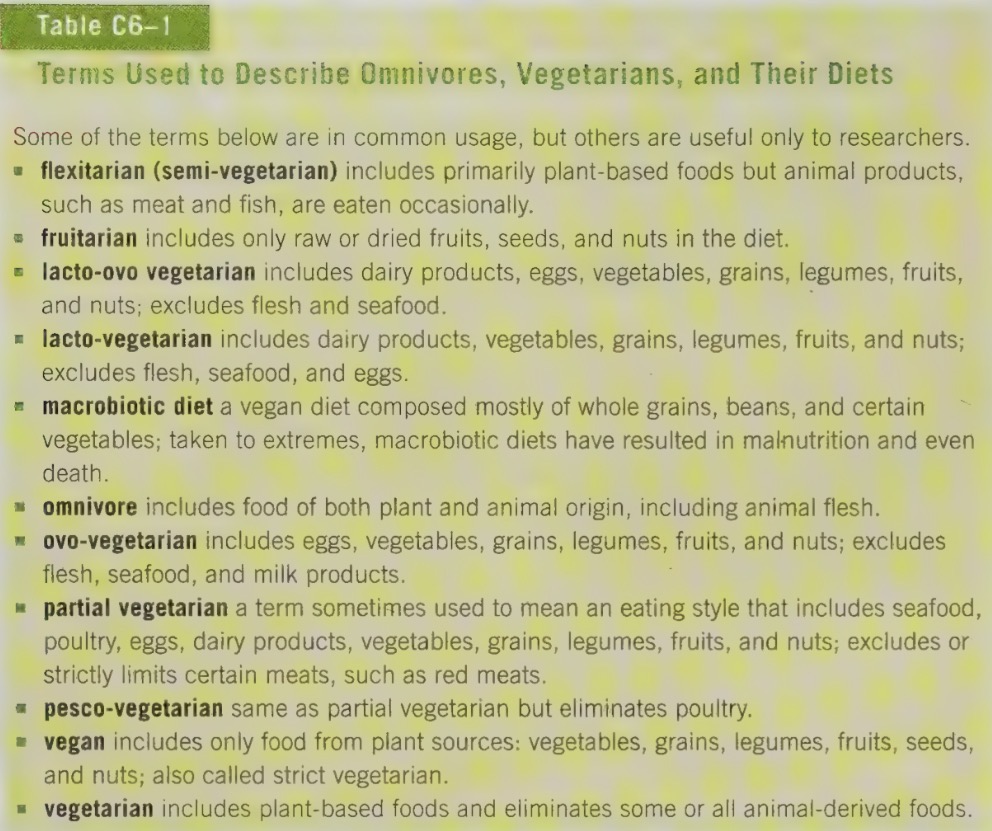
vegetarian
include plant based foods and eliminate some or all animal-derived foods
vegan
include only foods from plant sources: vegetables, fruit, grains, legumes, nuts and seeds. also called strict vegetarian
lacto-ovo vegetarian
includes dairy products, egg and all other foods in a vegan diet
lacto vegetarian
include dairy products and all other foods in vegan diet
ovo vegetarian
includes egg and all other foods in vegan diet
partial vegetarian
includes seafood, poultry, eggs, dairy products, vegetables, fruits, grains, legumes, nuts and seeds. Excludes or strictly limits certain meats, such as red meats.
pesco vegetarian
same as partial vegetarian but also eliminates poultry
fruitarian
includes only raw or dried fruits, seeds, and nuts in the diet
macrobiotic diets
composed of mostly whole grains, beans/legumes, fermented soy and certain vegetables with smaller amounts of nuts, seeds, and fruits
foods natural and unprocessed
vitamin/mineral supplements are not typically part of macrobiotic diet
combines zen buddism with vegetarian diet in greek means “long life” or “great life”
support philosophy of balancing foods to attain a balance of yin and yang
believed that food impacts health, happiness, and well being
taken to extreme person may progressive eliminate foods until only brown rice, herbal teas, and water remain
extreme macrobiotic diets resulted in malnutrition and even death
pros of vegetarianism
strong evidence of linking vegetarian diets with reduce incidence of chronic disease, other factors like excluding meats may come into play
higher vegetable and fruit intake - contribute vitamins, minerals, fibre, and phytochemical
more likely exclude tobacco and alcohol (or limit) and may be more physically active than non-vegetarians
despite limitations - evidence weighs in favour of vegetarian diets. some benefits include:
Weight control: In general, vegetarians maintain a healthier body weight than non vegetarians. Studies show that weight for height increases as meat consumption increases.
Heart disease: People who eat plant-based diets die less often from heart disease and related illnesses then people who eat meat. Vegetarian diets tend to be lower in saturated fat and cholesterol and higher in fibre. Plant based proteins, such as soy, may help to lower LDL cholesterol, triglyceride levels and blood pressure when consumed in place of animal protein.
Blood pressure: Vegetarians tend to have lower blood pressure and lower rates of hypertension.
Cancer: Vegetarians have significantly lower rates of cancer that the general population (e.g., colon cancer). However this may also be due to factors listed previously (e.g., higher vegetable/fruit intake, etc).
pros of an omnivorous diet
Optimal growth: Children who follow a vegan diet tend to be shorter and weigh less than children who consume animal products (e.g., omnivores or lacto-ovo vegetarians). It is not a huge difference, but still a difference. Vegan children often have a difficult time achieving adequate Vitamin B12, iron, zinc, calcium, Vitamin D and may have higher protein requirements that the general population (because protein sources are all from plants).
Easier to achieve needs during pregnancy: Women who eat meat, milk products and eggs can more easily ensure that they are receiving adequate Vitamin B12, Vitamin D, calcium, iron, zinc and protein to support a healthy pregnancy and to also support lactation.
Increased resistance to illness: Those who include animal foods in their diet may have more resistance to infections.
poorly planned vegetarian diets
protein - not as well absorbed in plant diet as in animal diet
iron - poorly absorbed DRI recommends vegetarian to have 1.8x more than normal diet
zinc - meat is richest form, soy interferes - DRI recommends variety of nutrient dense: whole grain, nuts, legumes
calcium - fortified beverages, some leafy greens, legumes, seeds, soy beans
vitamin B12: derived in animals, bacteria creates in fortified soy (but not active like in animals), seaweed, red star yeast
vitamin D - fortified foods (soy)
omega-3 fatty acids - DHA & EPA not consumed if no eat fish, consume more ALA (canola oil, flaxseed oil, soy beans, seafood oil)
poorly planned omnivorous diet can lack
vitamin A
vitamin C
folate and fibre (especially if intake of vegetables and fruit is low)